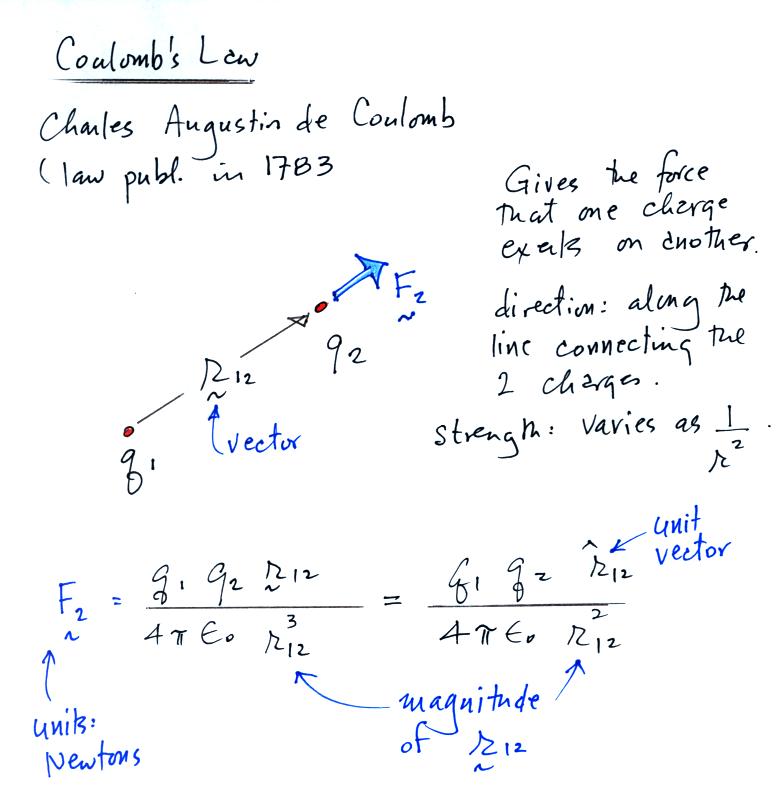
If q1 and q2 both have the same
polarity q2 will be repelled by q1. If they have opposite
charges, q2 will be attracted to q1. The strength of the force
depends on the inverse square of the distance between the two
charges.
A few comments about notation. The "squiggly" line under a variable ( ~ ) denotes a vector. The caret above a variable ( ^ ) indicates a unit vector. The indices r12 indicate that the vector points from 1 toward 2. We'll also mostly be using the mks system of units in this course.
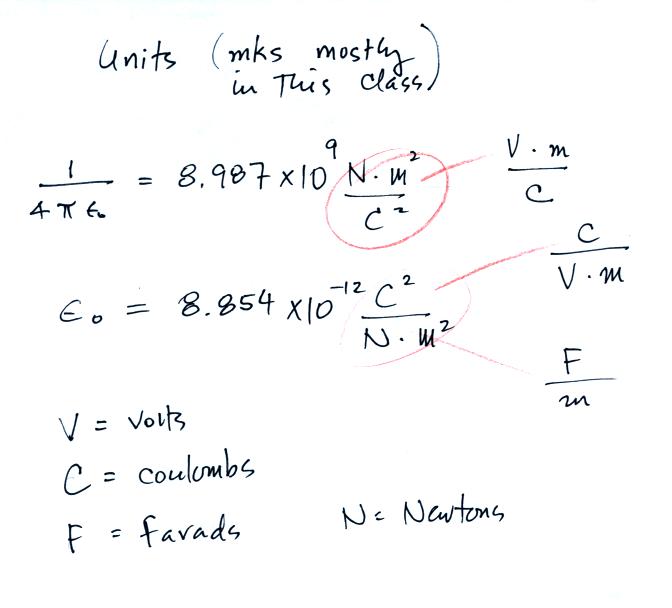
A few comments about notation. The "squiggly" line under a variable ( ~ ) denotes a vector. The caret above a variable ( ^ ) indicates a unit vector. The indices r12 indicate that the vector points from 1 toward 2. We'll also mostly be using the mks system of units in this course.

I'd encourage you to put all the
constants and
units together on one page so that you can refer to for homework and
exam questions.
The principle of superposition applies with Coulomb's law.
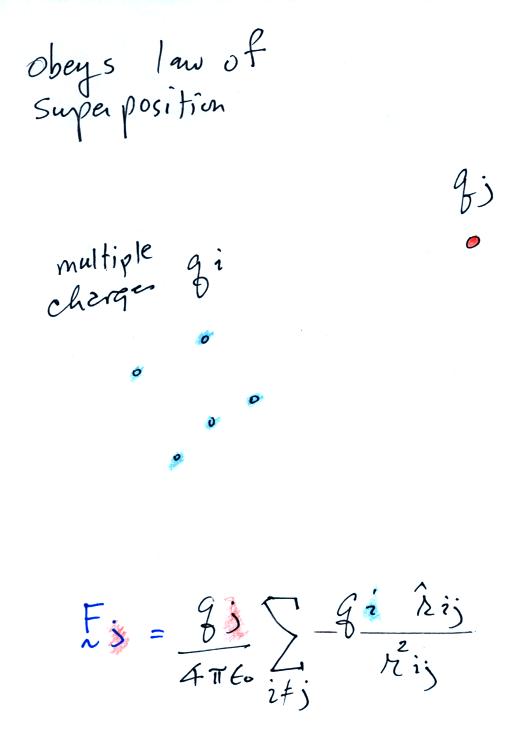
When multiple charges are present, the force exerted on one of
the charges is the vector sum of the forces exerted on the charge by
all the other charges.
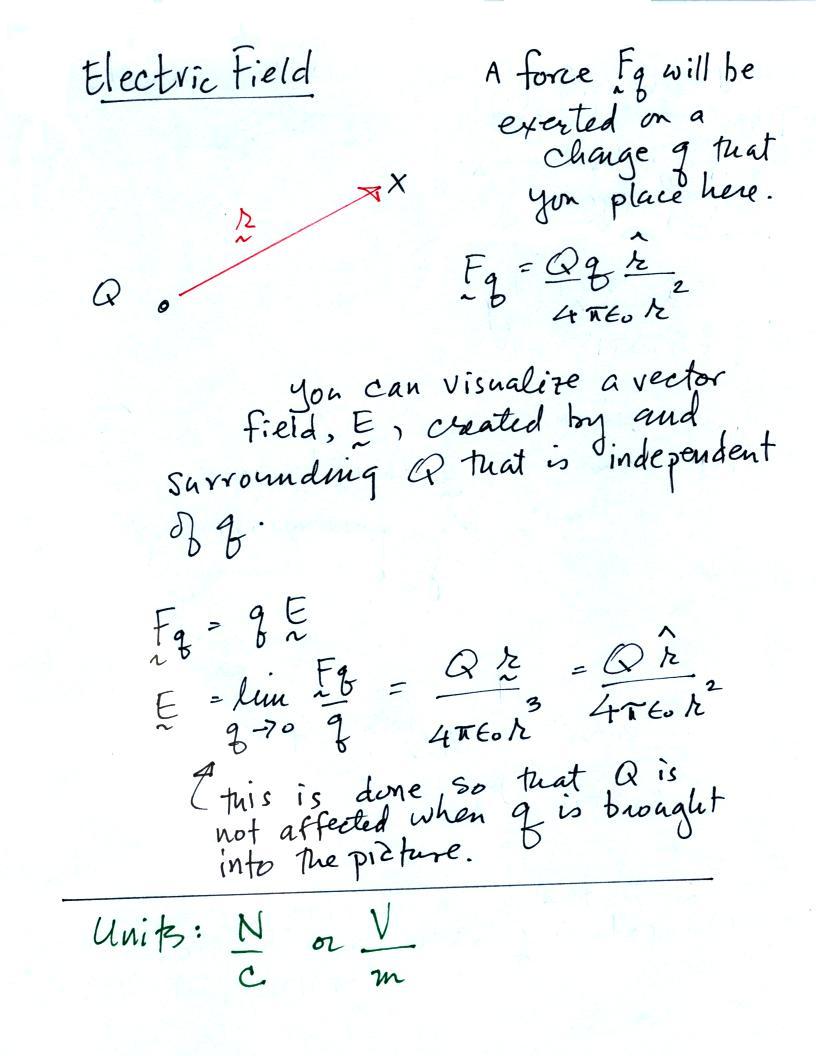
If a charge q is placed in the vicinity of a charge Q, we could use Coulomb's law to determine the force that Q exerts on q. We can imagine a vector field, the electric field, existing around Q even before q is brought into the picture. Multiplying q times E would give the force that Q exerts on q. The expression for electric field is shown above.
We'll try an example problem: calculating the electric field a distance r away from an infinitely long line of charge (charge is distributed uniformly along the line). The symbol λ will stand for the line charge density (careful: λ is often used for conductivity as well)
We'll write down expressions for the contributions to the field dE from short segments above and below z = 0. The z components of the E field at Point r point in opposite directions and cancel out. The radial components point in the r-direction (away from line of charge) and add.
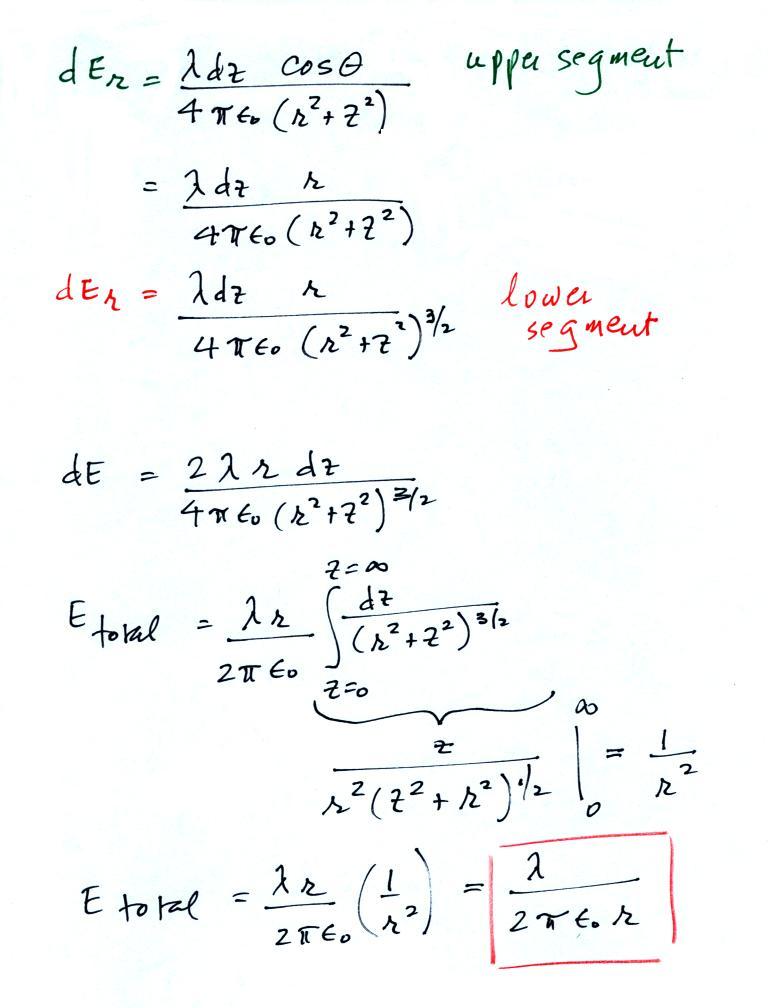
The principle of superposition applies with Coulomb's law.


If a charge q is placed in the vicinity of a charge Q, we could use Coulomb's law to determine the force that Q exerts on q. We can imagine a vector field, the electric field, existing around Q even before q is brought into the picture. Multiplying q times E would give the force that Q exerts on q. The expression for electric field is shown above.
We'll try an example problem: calculating the electric field a distance r away from an infinitely long line of charge (charge is distributed uniformly along the line). The symbol λ will stand for the line charge density (careful: λ is often used for conductivity as well)

We'll write down expressions for the contributions to the field dE from short segments above and below z = 0. The z components of the E field at Point r point in opposite directions and cancel out. The radial components point in the r-direction (away from line of charge) and add.

To determine the total field we
must include all the segments from z = 0 to infinity. We must
integrate the expression for dE from 0 to infinity. The solution
is shown at the bottom of the figure.
We'll come back to this problem later in this lecture and solve it in a much simpler way.
Next we'll consider a charge completely surrounded and enclosed by a surface, S.
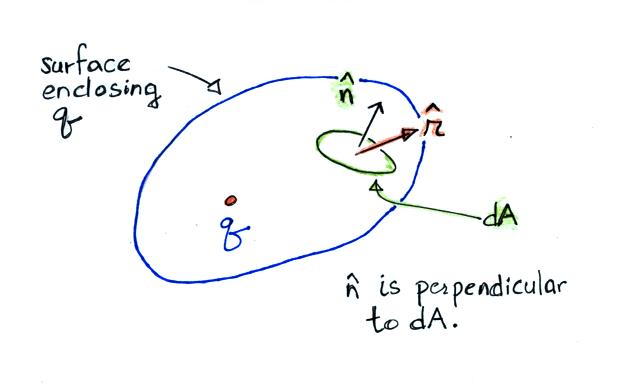
The vector r points outward from q and n is a unit vector normal (perpendicular) to the small increment of area dA.
We will evaluate the following surface integral

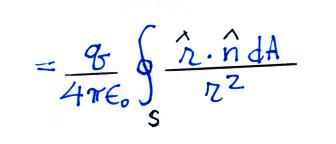


The surface
integral of electric field over a surface enclosing a charge q is just
q divided by εo the integral form
of Gauss' Law. The shape of the surface is irrelevant.
To see how useful this expression can be we'll return to our earlier problem involving the infinite line of charge and use Gauss' Law to determine the electric field. We'll see that it is a much easier process.
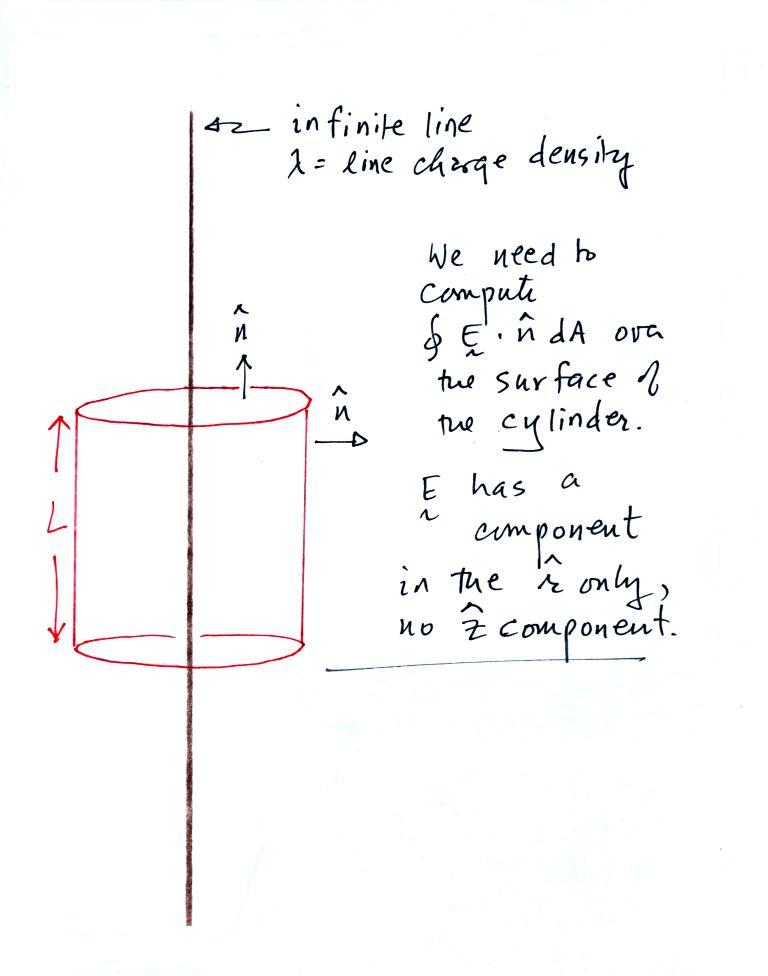
The crucial part of the problem is the choice of surface. We
draw a cylinder centered on the line of charge. This is the
area that we will integrate E over in the Gauss Law expression.
It is also important to realize that the E field has a radial component
only.

There is no contribution to the surface integral from the ends of
the
cylinder (E is perpendicular to the normal vector, the dot productand E
and n is
therefore zero). E is parallel to the normal vector along the
side of the
cylinder. E is also constant on the side of the cyliner (E is a
function of r and r stays constant as you integrate over the surface of
the cylinder side). In the end we obtain the same expression for
E as we did in the earlier example.
It's relatively easy to show that the surface integral of the E is zero when charge is located outside the volume.
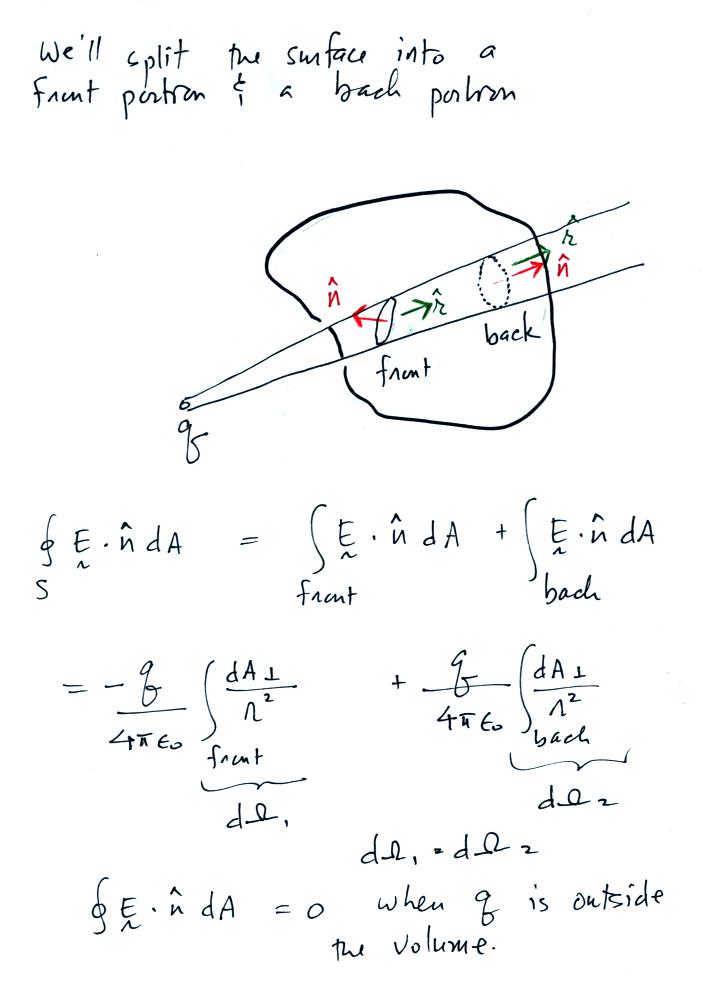
This might be a little hard to visualize because the figure isn't drawn very well. But along the front portion of the surface the r unit vector points inward, n points outward. Along the back surface r and n both point outward. The two increments of solid angle have the same value but opposite signs so they cancel.
We'll go back to the integral form of Gauss' Law.

A surface S contains a volume V. We can use the divergence theorem to write the surface integral of electric field as a volume integral of the dot product of electric field. The charge enclosed by the surface is just the volume integral of the volume charge density. Combining these two expressions
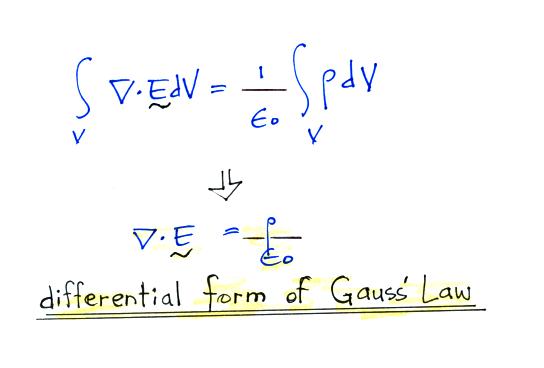
In order for the two volume integrals to be equal for an arbitrary
volume, the terms inside the integrals must be indentical.
It's been a long lecture, we're almost done.
Next we imagine placing a conductor in an electric field

Free electrons inside the conductor will quickly move around and redistribute themselves in such a way that they will cancel out the field in the conductor (as the electrons move they leave behind positively charged atoms). Very quickly the field inside the conductor will become zero. There is also no space charge inside the conductor, all the charge is distributed along the surface on the conductor. The electric field lines in the vicinity of the conductor will be distorted and will strike the surface of the conductor perpendicular (if there were any tangential component, charges would move and cancel it out).
Next we'll use Gauss' Law to determine a relationship between the surface charge density and the electric field strength at the surface of a conductor.

A cylindrical volume, half inside and half outside the conductor
is
used. You must integrate the electric field, E, over the surface
of the cylinder.
1. The E field is zero inside the conductor. So you get no contribution to the surface integral from the bottom end of the cylinder.

2. Both the sides of the cylinder and the E field
lines are
perpendicular to the surface of the conductor. The dot product of
E and the normal to the cylinder surface is zero (E and n are
perpendicular) So there is no contribution to
the surface integral from the sides of the cylinder.

3. The only contribution comes from the top end of the
cylinder. E and the normal vector are parallel. So the
contribution from the top end is just E A, where A is the area of the
top end of the cylinder. The charge enclosed is just A σ,
where σ is
the surface charge density. The electric field
at the surface of the conductor is perpendicular to
the conductor and has the value highlighted in yellow.

We'll come back to this problem later in this lecture and solve it in a much simpler way.
Next we'll consider a charge completely surrounded and enclosed by a surface, S.

The vector r points outward from q and n is a unit vector normal (perpendicular) to the small increment of area dA.
We will evaluate the following surface integral

Substituting in the expression for
electric field surrounding a point charge.

This could be a difficult integral
to evaluate for a surface of arbitrary shape. However we can
first note that the surface integral can be rewritten as an integral of
solid angle over a closed surface.

The increment of solid angle dΩ is
really just a 3-dimensional version of an increment of angle
dθ.
The
following figure might make this clearer.


In the upper figure a line of
length r sweeps through some angle
increment dθ traces out a segment of length rdθ. In the bottom
figure r times an increment of solid angle dΩ maps out an area r2 dΩ.
It is relatively easy to show that the integral of solid angle over a surface is 4 π.
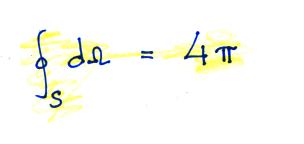
It is relatively easy to show that the integral of solid angle over a surface is 4 π.

To do this we just consider a
sphere.

Now let's go back to the surface
integral of the electric field.
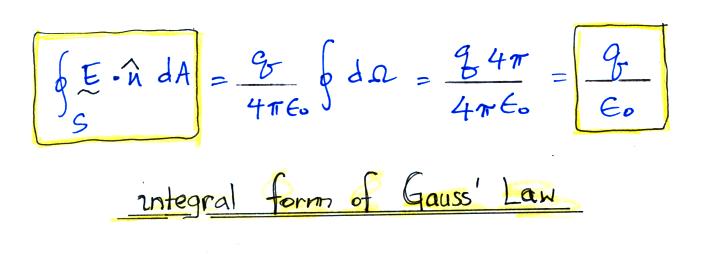

To see how useful this expression can be we'll return to our earlier problem involving the infinite line of charge and use Gauss' Law to determine the electric field. We'll see that it is a much easier process.


It's relatively easy to show that the surface integral of the E is zero when charge is located outside the volume.

This might be a little hard to visualize because the figure isn't drawn very well. But along the front portion of the surface the r unit vector points inward, n points outward. Along the back surface r and n both point outward. The two increments of solid angle have the same value but opposite signs so they cancel.
We'll go back to the integral form of Gauss' Law.

A surface S contains a volume V. We can use the divergence theorem to write the surface integral of electric field as a volume integral of the dot product of electric field. The charge enclosed by the surface is just the volume integral of the volume charge density. Combining these two expressions

It's been a long lecture, we're almost done.
Next we imagine placing a conductor in an electric field

Free electrons inside the conductor will quickly move around and redistribute themselves in such a way that they will cancel out the field in the conductor (as the electrons move they leave behind positively charged atoms). Very quickly the field inside the conductor will become zero. There is also no space charge inside the conductor, all the charge is distributed along the surface on the conductor. The electric field lines in the vicinity of the conductor will be distorted and will strike the surface of the conductor perpendicular (if there were any tangential component, charges would move and cancel it out).
Next we'll use Gauss' Law to determine a relationship between the surface charge density and the electric field strength at the surface of a conductor.

1. The E field is zero inside the conductor. So you get no contribution to the surface integral from the bottom end of the cylinder.


